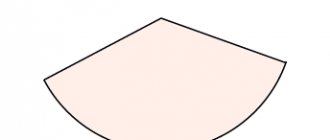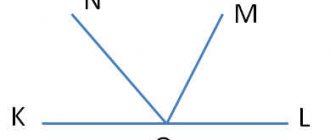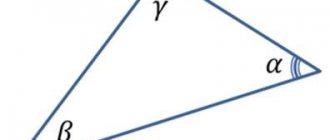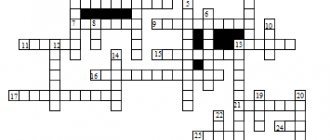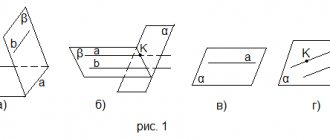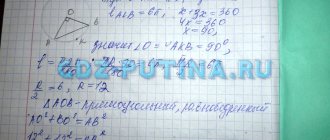Test on the topic “Areas of figures”
Test on the topic “Areas of figures”
This test is intended for current and final monitoring of the formation of students’ basic skills in finding the areas of figures on a plane; the test also allows you to systematize students’ knowledge on the topic “Areas of Figures” and timely identify gaps in the material studied. Problems on finding areas are included in the content of the OGE and the Unified State Exam in mathematics. To prepare for these exams, it is necessary to develop reliable and stable abilities of schoolchildren to solve basic problems.
Option 1
1. Find the area of the parallelogram shown in the figure.
Answer options: 1) 171 2) 342 3) 85.5 4) 209
2. Find the area of the triangle shown in the figure.
.
Answer options: 1) 1075 2) 537.5 3) 1500 4) 1290
3. Find the area of the isosceles triangle shown in the figure.
Answer options: 1) 120 2) 255 3) 84 4) 168
4. In a triangle, one of the sides is 12, the other is 8, and the sine of the angle between them is 0.2. Find the area of the triangle.
Answer options: 1) 9.6 2) 4.8 3) 48 4) 96
5. Find the area of the trapezoid shown in the figure.
Answer options: 1) 180 2) 120 3) 72 4) 90
6. Find the area of the trapezoid shown in the figure.
Answer options: 1) 144 2) 72 3) 288 4) 108
7. The base of the trapezoid is 22, the height is 12, the area of the trapezoid is 324. Find the second base of the trapezoid.
Answer options: 1) 32 2) 16 3) 11 4) 17
8. The area of a circle is 441π. Find the radius of the circle.
Answer options: 1) 21 2) 23 3) 4) 2, 1
9. Find the area of a triangle depicted on checkered paper with a cell size of 1 cm x 1 cm. Give your answer in square centimeters.
Answer options: 1) 8 2) 16 3) 12 4) 6
10. The side of a rhombus is 5, one of the diagonals is 6. Find the area of the rhombus.
Answer options: 1) 24 2) 48 3) 12 4) 30
11. The perimeter of a rhombus is 100, and one of the angles is 300. Find the area of the rhombus.
Answer options: 1) 312.5 2) 625 3) 1250 4) 200
12. The bases of a trapezoid are equal to 12 and 18, one of the sides is equal to
, and the angle between it and one of the bases is 1350. Find the area of the trapezoid.
Answer options: 1) 135 2) 162 3) 108 4) 270
13. Find the area of a square if its diagonal is 18.
Answer options: 1) 162 2) 324 3) 81 4) 169
14. The bases of an isosceles trapezoid are 14 and 20, and its sides are 5. Find the area of the trapezoid.
Answer options: 1) 68 2) 34 3) 70 4) 80
15. The sides of a parallelogram are 4 and 8. The height of the first of these sides is 6. Find the height of the second side of the parallelogram.
Answer options: 1) 3 2) 4 3) 2 3) 6
Option 2
1. Find the area of the parallelogram shown in the figure.
Answer options: 1) 297 2) 154 3) 148.5 4) 104
2. Find the area of the triangle shown in the figure.
Answer options: 1) 178.5 2) 357 3) 204 4) 252
3. Find the area of the isosceles triangle shown in the figure.
Answer options: 1) 168 2) 252 3) 196 4) 100
4. In a triangle, one of the sides is 24, the other is 16, the sine of the angle between them is 0.8. Find the area of the triangle.
Answer options: 1) 153.6 2) 128 3) 307.2 4) 168
5. Find the area of the trapezoid shown in the figure.
Answer options: 1)390 2)195 3) 370 4) 340
6. Find the area of the trapezoid shown in the figure.
Answer options: 1) 144 2) 72 3) 112 4) 288
7. The base of the trapezoid is 29, the height is 18, the area of the trapezoid is 333. Find the second base of the trapezoid.
Answer options: 1) 8 2) 9 3) 11 4) 6
8. The area of a circle is 529π. Find the radius of the circle.
Answer options: 1) 23 2) 24 3) 4) 21
9. Find the area of a triangle depicted on checkered paper with a cell size of 1 cm x 1 cm. Give your answer in square centimeters
Answer options: 1) 8.5 2) 8 3) 7.5 )4 9
10. The side of a rhombus is 25, one of the diagonals is 48. Find the area of the rhombus.
Answer options: 1) 336 2) 672 3) 625 4) 168
11. The perimeter of a rhombus is 44, and one of the angles is 300. Find the area of the rhombus.
Answer options: 1) 60.5 2) 121 3) 68.5 4) 242
12. The bases of the trapezoid are 6 and 20, one of the sides is equal, and the angle between it and one of the bases is 1350. Find the area of the trapezoid.
Answer options: 1) 169 2) 91 3) 182 4) 120
13. Find the area of a square if its diagonal is 25.
Answer options: 1) 312.5 2) 315 3) 288 4) 625
14. The bases of an isosceles trapezoid are 19 and 29, and its sides are 13. Find the area of the trapezoid.
Answer options: 1) 288 2) 144 3) 174 4) 114
15. The sides of a parallelogram are 22 and 44. The height of the first of these sides is 33. Find the height of the second side of the parallelogram.
Answer options: 1) 16.5 2) 11 3) 22 4) 17.5
Answers:
the correct answers are all numbered 1)
Test assignments on the topic “Areas”, grade 8 (humanities)
Assignments for testing on the topic: “Area” (8th grade. Chapter
VI .)
Card No. 1
Theoretical part.
- Formulate the basic properties of the areas of polygons.
- Formulate and prove a theorem about calculating the area of a rectangle.
Practical part.
- In a right triangle, the legs are 15 and 20 cm. Find the area
- Find the heights of a parallelogram with sides 10 and 6 cm if its area is equal to
30 cm.
- The diagonals of the trapezoid are mutually perpendicular and equal to 4 and 10 cm. Find the area of the trapezoid.
- Find the area of the rhombus based on its diagonals 8 and 12 cm.
- In a rectangle, one side is 10 and the other side is 14. Find the diagonal and area of the rectangle.
Card No. 2
Theoretical part.
- Which triangle is called a right triangle? How to calculate the area of a right triangle from its legs?
- Formulate and prove a theorem about calculating the area of a parallelogram.
Practical part.
- Find the area of a right triangle if its hypotenuse is 20 cm and one of its legs is 12 cm.
- One of the sides of the parallelogram is 20, and the height lowered on it is 23. Find the area of the parallelogram.
- One of the sides of the trapezoid is perpendicular to the base. Find the area of the trapezoid if one of its angles is 45 and the lengths of the sides are 6 and 8 cm.
- In a rhombus, the side is 10, one of the diagonals is 12. Find the other diagonal and area of the rhombus.
- In a rectangle, one side is 1 and the other side is 17. Find the diagonal and area of the rectangle.
Card No. 3
Theoretical part.
- What triangles are called Pythagorean triangles? Give examples of Pythagorean triangles.
- Formulate and prove a theorem about calculating the area of a triangle.
Practical part.
- Right triangle with legs 5 and 12 cm. Find the area and perimeter of the triangle
- One of the sides of the parallelogram is 16, and the height lowered on it is 25. Find the area of the parallelogram.
- The bases of the trapezoid are equal to 4 and 25, one of the sides is equal to , and the angle between it and one of the bases is equal to . Find the area of the trapezoid.
- The side of a rhombus is 29 and the diagonal is 42. Find the area of the rhombus.
- In a rectangle, one side is 13 and the other side is 9. Find the diagonal and area of the rectangle.
Card No. 4
Theoretical part.
- Which triangle is called the Egyptian triangle? Explain.
- Formulate and prove a theorem about calculating the area of a trapezoid
Practical part.
- Find the area of an isosceles triangle with a side of 17 cm and a base of 16 cm.
- One of the sides of the parallelogram is 19, and the height lowered on it is 27. Find the area of the parallelogram
- The bases of the trapezoid are equal to 16 and 18, one of the sides is equal to , and the angle between it and one of the bases is equal to . Find the area of the trapezoid.
- The perimeter of a rhombus is 28, and one of the angles is . Find the area of the rhombus.
- In a rectangle, one side is 13 and the perimeter is 62. Find the area of the rectangle.
Card No. 5
Theoretical part.
- Formulate a theorem on the ratio of the areas of two triangles that have equal angles.
- State and prove the Pythagorean theorem.
Practical part.
- Find the area of a regular triangle with side 8 cm.
- The sides of the parallelogram are 12 and 15 cm. The height drawn to the larger side is 8 cm. Find the second height of the parallelogram.
- The bases of the trapezoid are equal to 21 and 22, one of the sides is equal to , and the angle between it and one of the bases is equal to . Find the area of the trapezoid.
- In a rhombus, the side is 33, one of the diagonals is , and the angle opposite this diagonal is . Find the area of the rhombus.
- In a rectangle, one side is 14 and the perimeter is 54. Find the area of the rectangle.
Card No. 6
Theoretical part.
- State the converse of the Pythagorean theorem.
- Formulate and prove a theorem about calculating the area of a rectangle.
Practical part.
- In a right triangle, one of the legs is equal to , the angle opposite it is equal to , and the hypotenuse is equal to 34. Find the area of the triangle
- A diagonal of a parallelogram equal to 13 cm is perpendicular to a side equal to 12 cm. Find the area of the parallelogram.
- The bases of the trapezoid are equal to 9 and 24, one of the sides is equal to , and the angle between it and one of the bases is equal to . Find the area of the trapezoid.
- The side of a rhombus is 73 and the diagonal is 110. Find the area of the rhombus.
- In a rectangle, the diagonal is 92, and the angle between it and one of the sides is , the length of this side is 46. Find the area of the rectangle.
Card No. 7
Theoretical part.
- Formulate the basic properties of the areas of polygons.
- Formulate and prove a theorem about calculating the area of a rectangle.
Practical part.
- The perimeter of an isosceles triangle is 392 and the base is 192. Find the area of the triangle.
- The sides of the parallelogram are 12 and 15 cm. The height drawn to the larger side is 8 cm. Find the second height of the parallelogram.
- The bases of the trapezoid are equal to 4 and 12, one of the sides is equal to , and the angle between it and one of the bases is equal to . Find the area of the trapezoid
- The perimeter of a rhombus is 128, and one of the angles is . Find the area of a rhombus
- In a rectangle, one side is 84 and the diagonal is 91. Find the area of the rectangle
Card No. 8
Theoretical part.
- What triangles are called Pythagorean triangles? Give examples of Pythagorean triangles.
- State and prove the Pythagorean theorem.
Practical part
- In a triangle, one of the sides is equal to 2, and the height lowered to it is 17. Find the area of the triangle.
- Adjacent sides of a parallelogram are 14 cm and 12 cm, and its acute angle is equal to . Find the area of the parallelogram
- The bases of the trapezoid are equal to 1 and 17, one of the sides is equal to , and the angle between it and one of the bases is equal to . Find the area of the trapezoid.
- In a rhombus, the side is 38, one of the diagonals is , and the angle opposite this diagonal is . Find the area of the rhombus.
- In a rectangle, one side is 52 and the diagonal is 65. Find the area of the rectangle
Card No. 9
Theoretical part.
- Formulate a theorem on the ratio of the areas of two triangles that have equal angles.
- Formulate and prove a theorem about calculating the area of a trapezoid
Practical part.
- The perimeter of an isosceles triangle is 216 and the base is 96. Find the area of the triangle
- The sides of the parallelogram are 24 cm and 18 cm, and its area is 144 cm². Find the heights of the parallelogram
- Find the area of a rectangular trapezoid whose two smaller sides are 6 cm and the larger angle is 135°
- The side of a rhombus is 95 and the diagonal is 114. Find the area of the rhombus.
- In a rectangle, the diagonal is 42, and the angle between it and one of the sides is . Find the area of the rectangle.
Card number 10
Theoretical part.
- Which triangle is called the Egyptian triangle? Explain.
- Formulate and prove a theorem about calculating the area of a triangle.
Practical part.
- The perimeter of an equilateral triangle is 114. Find its area
- The sides of the parallelogram are 10 cm and 12 cm, and one of the angles is 150°. Find the area of a parallelogram
- The height of the trapezoid is 7 cm, and one of the bases is 5 times larger than the other. Find the bases of the trapezoid if its area is 84 cm².
- In a rhombus, the side is 22, one of the diagonals is , and the angle from which this diagonal emerges is . Find the area of the rhombus.
- In a rectangle, the diagonal is 96, the angle between it and one of the sides is equal, and the length of this side is . Find the area of the rectangle.
Card No. 11
Theoretical part.
- State the converse of the Pythagorean theorem.
- Formulate and prove a theorem about calculating the area of a parallelogram.
Practical part.
- In an isosceles triangle, the lateral side is 94 and the angle opposite the base is . Find the area of the triangle.
- The heights of the parallelogram are 2 cm and 6 cm, and its area is 48 cm². Find the lengths of the parallelogram sides
- In a rectangular trapezoid, the bases are 6 cm and 9 cm, and the largest side is 5 cm. Find the area of the trapezoid.
- In a rhombus, the side is 54, one of the diagonals is 54, and the angle from which this diagonal emerges is . Find the area of the rhombus.
- In a rectangle, one side is 45 and the diagonal is 53. Find the area of the rectangle.
Card number 12
Theoretical part.
- Which triangle is called a right triangle? How to calculate the area of a right triangle from its legs?
- Formulate and prove a theorem about calculating the area of a rectangle.
Practical part.
- The height of an equilateral triangle is 7. Find its area.
- The heights of the parallelogram are 12 cm and 9 cm, and its area is 36 cm². Find the lengths of the sides of the parallelogram.
- In an isosceles trapezoid, the bases are 6 cm and 14 cm, and the side is 5 cm. Find the area of the trapezoid.
- The side of a rhombus is 90 and the diagonal is 144. Find the area of the rhombus.
- In a rectangle, the diagonal is 4, and the angle between it and one of the sides is , the length of this side is 2. Find the area of the rectangle.
Card number 13
Theoretical part.
- Formulate the basic properties of the areas of polygons.
- Formulate and prove a theorem about calculating the area of a parallelogram.
Practical part.
- In a right triangle, one of the legs is equal to 10, and the acute angle adjacent to it is equal to . Find the area of the triangle.
- The sides of the parallelogram are 8 cm and 14 cm, and one of the angles is 30°. Find the area of a parallelogram
- The difference between the bases of the trapezoid is 6 cm, and the height is 8 cm. Find the bases of the trapezoid if its area is 56 cm².
- In a rhombus, the side is 10, one of the diagonals is 10, and the angle from which this diagonal emerges is . Find the area of the rhombus.
- In a rectangle, one side is 16 and the perimeter is 58. Find the area of the rectangle.
Card number 14
Theoretical part.
- State the converse of the Pythagorean theorem.
- Formulate and prove a theorem about calculating the area of a trapezoid.
Practical part.
- The side of an equilateral triangle is 48. Find its area.
- The perimeter of the parallelogram is 66 cm. The two angles of the parallelogram are in the ratio 1:5, and the sides are 2:9. Find the area of the parallelogram.
- The height of the trapezoid is 3 times less than one of the bases and 5 times less than the other. Find the bases of the trapezoid if its area is 100 cm².
- In a rhombus, the side is 68, one of the diagonals is 68, and the angle opposite this diagonal is . Find the area of the rhombus.
- In a rectangle, one side is 15 and the diagonal is 17. Find the area of the rectangle
Card number 15
Theoretical part.
- Which triangle is called the Egyptian triangle? Explain.
- State and prove the Pythagorean theorem.
Practical part
- In a right triangle, one of the legs is equal to 10, and the angle opposite it is equal to . Find the area of the triangle.
- The perimeter of the parallelogram is 32 cm. Find the area of the parallelogram if one of the angles is greater than the right angle and one of the sides is 6 cm.
- A height drawn from the vertex of an obtuse angle of a right-angled trapezoid cuts off a square whose area is 16 cm². Find the area of a trapezoid if its obtuse angle is 135°
- In a rhombus, the side is 16, one of the diagonals is , and the angle from which this diagonal emerges is . Find the area of the rhombus.
- The distance from the point of intersection of the diagonals of the rectangle to one of its sides is 8 times less than this side. Find the area of a rectangle if its perimeter is 80 cm.
Card number 16
Theoretical part.
- Which triangle is called a right triangle? How to calculate the area of a right triangle from its legs?
- Formulate and prove a theorem about calculating the area of a triangle.
Practical part
- Find the area of a triangle with sides 17, 65 and 80 cm.
- In a parallelogram, the acute angle is 30°. The bisector of this angle divides the side of the parallelogram into segments of 14 cm and 9 cm, counting from the vertex of the obtuse angle. Find the area of a parallelogram
- The acute angle of an isosceles trapezoid is 45°. The sum of the lengths of its sides and the smaller base is equal to 18√2 cm. Find the height and area of the trapezoid if its diagonal is the bisector of the angle at the base.
- In a rhombus, the side is 54, one of the diagonals is 54, and the angle from which this diagonal emerges is . Find the area of the rhombus.
- The distance from the point of intersection of the diagonals of the rectangle to one of its sides is 8 cm less than this side. Find the area of a rectangle if its perimeter is 88 cm.
Card number 17
Theoretical part.
- Which triangle is called a right triangle? How to calculate the area of a right triangle from its legs?
- State and prove the Pythagorean theorem.
Practical part
- The sides of the triangle are 8cm, 10cm, 12cm. Find the area of the triangle
- The sides of the parallelogram are 24 cm and 52 cm, and one of the angles is 30°. Find the area of a parallelogram
- The sides of a rectangular trapezoid are 7 and 25 cm, and the smaller base is 2 cm. Find the area of the trapezoid.
- In a rhombus, the side is 44, one of the diagonals is 44, and the angle from which this diagonal emerges is . Find the area of the rhombus.
- The areas of the squares built on the sides of the rectangle are 64 cm² and 121 cm². Find the area of the rectangle.
Card number 18
Theoretical part.
- What triangles are called Pythagorean triangles? Give examples of Pythagorean triangles.
- Formulate and prove a theorem about calculating the area of a rectangle.
Practical part
- The area of a right isosceles triangle is 16 cm2. Find the hypotenuse of this triangle.
- Adjacent sides of a parallelogram are 28 cm and 24 cm, and its acute angle is equal to . Find the area of the parallelogram
- In an isosceles trapezoid, the bases are 12 cm and 20 cm, and the side is 5 cm. Find the area of the trapezoid.
- In a rhombus, the side is 44, one of the diagonals is 44, and the angle from which this diagonal emerges is . Find the area of the rhombus.
- Find the area of a rectangle if its perimeter is 144 cm and its sides are in a ratio of 5:7.
Card number 19
Theoretical part.
- State the converse of the Pythagorean theorem.
- Formulate and prove a theorem about calculating the area of a parallelogram.
Practical part.
- The side of an isosceles triangle is 15 cm, and the base is 24 cm. What is the area of the triangle?
- The heights of the parallelogram are 5 cm and 4 cm, and the perimeter is 42 cm. Find the area of the parallelogram.
- In a rectangular trapezoid, the bases are 22 and 6 cm, and the largest side is 20 cm. Find the area of the trapezoid
- One of the diagonals of a rhombus is 4 cm larger than the other, and the area of the rhombus is 96 cm2. Find the sides of the rhombus.
- Find the area of a rectangle if its perimeter is 74 cm and the difference in sides is 17 cm.
Card number 20
Theoretical part.
- Which triangle is called a right triangle? How to calculate the area of a right triangle from its legs?
- State and prove the Pythagorean theorem.
Practical part.
- The area of a right triangle is 24 m2, one leg of which is 3 times larger than the other. Find the hypotenuse of the triangle.
- The diagonal of a parallelogram is equal to its side. Find the area of a parallelogram if its longest side is 15.2 cm and one of its angles is
- Find the area of an isosceles trapezoid whose bases are 16 cm and 18 cm, and whose side makes an angle of 100 cm with one of the bases.
- In a rhombus, the side is 10, one of the diagonals is 10, and the angle from which this diagonal emerges is . Find the area of the rhombus.
- Find the area of a square if its perimeter is 4 cm.
